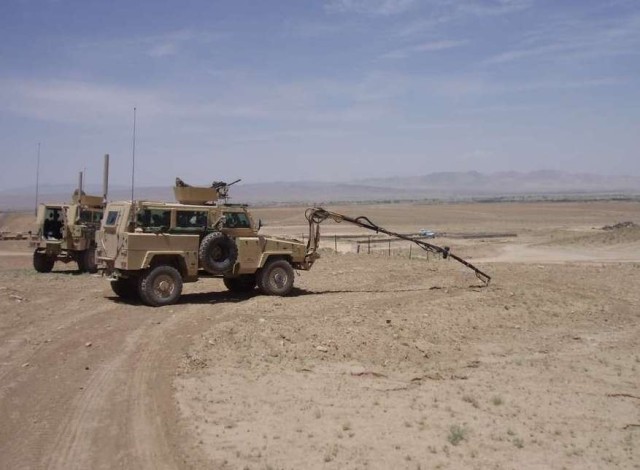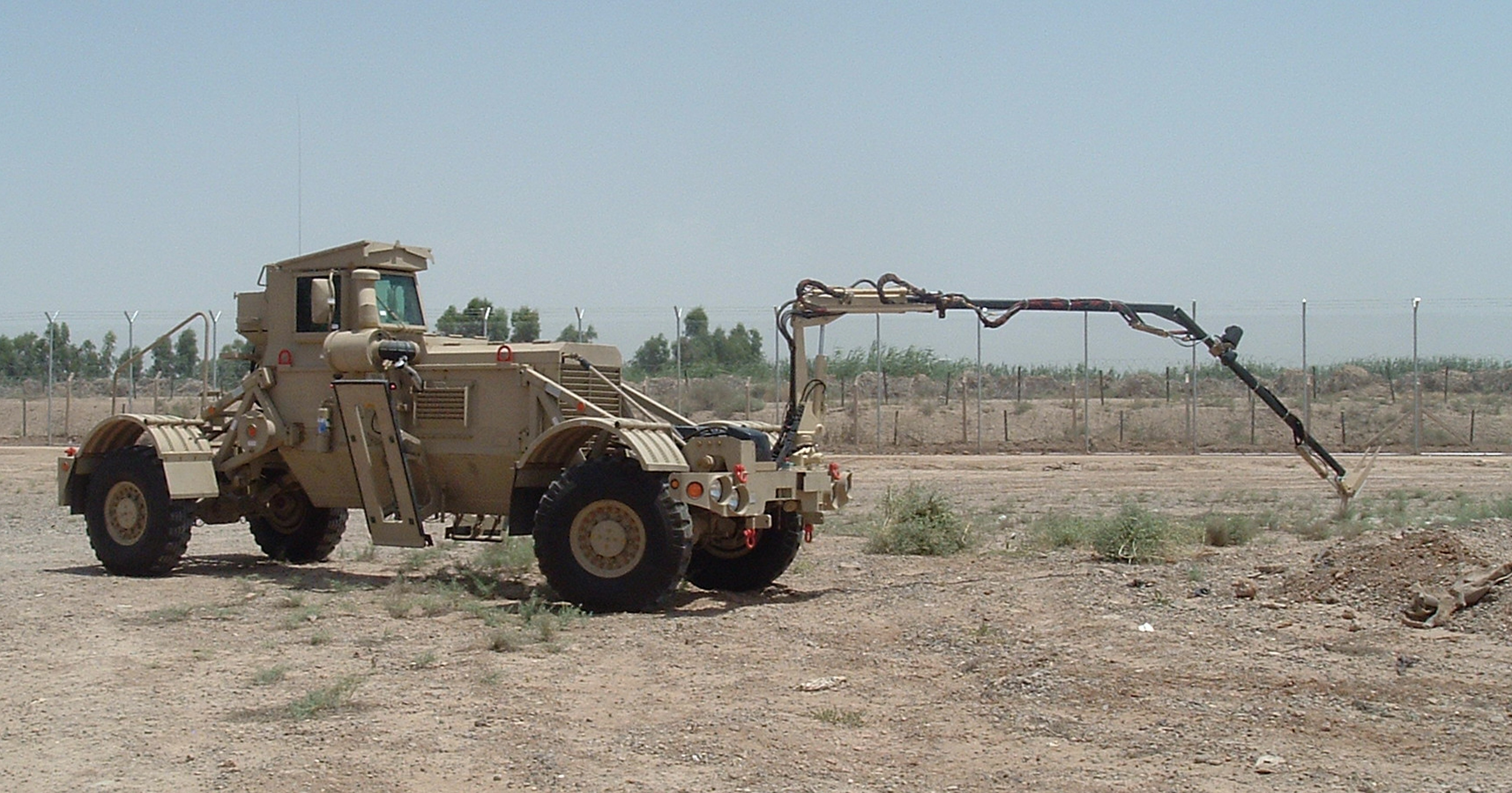The U.S. Army is confronting a new kind of warfare. The current Iraq War, in contrast to the Gulf War of the early 1990s, has spawned an environment where unconventional warfare has become the norm. One ever-present characteristic of this new brand of warfare is the indiscriminate use of improvised explosive devices by enemy insurgents.
"In 1991, you had two armies facing off across an empty desert," said Stephen H. Bennett, mechanical engineer at the Night Vision and Electronic Sensors Directorate. "But when you have two large armies going at each other, there is less concern for civilian casualties, as there aren't as many civilians around. This time, you have a very narrow area in which you can conduct your operation, where the goal is not only to be victorious over the insurgents, but at the same time to not disaffect the civilian populous."
The NV&ESD developed the Interrogation Arm for the RG-31 and Husky vehicles in response to this shift in engagement.
According to NV&ESD Team Lead Larry Jackson, the arm was designed for use by route clearance teams who are charged with detecting and neutralizing potentially deadly IEDs.
"There are several vehicles that are used for route clearance missions," said Jackson. These missions, during which Soldiers attempt to find as many IEDs along the roads as possible, are critical to those who will need to travel those roads safely later in the day.
Previously, a vehicle called the Buffalo was the primary IED interrogation vehicle. However, according to Jackson, the Buffalo, while effective, wasn't always available.
"The word we got back from theater is that the Soldiers often don't have the Buffalos when they need them. The vehicle is in high demand, and there just aren't enough of them," he said.
So in collaboration with the team at NV&ESD, discussions began for a new technology that could be quickly developed and fielded.
"We said we would like to provide a similar arm capability to vehicles such as the Husky and the RG-31, which were being used in security missions but had no arm attachment that would allow for IED interrogation," he said.
The new arm, which was initially fielded in Iraq in May 2007 and in Afghanistan in July 2007, capitalizes on the IED interrogation capabilities of the Buffalo. Designed as an independent component, it can be attached to vehicles already in theater. Additionally, the arm is lightweight, easy to mount and repair, easy to use and significantly less expensive than the Buffalo, Jackson said.
"The feedback has been positive, and the troops like it," said Bennett, who was present in Iraq last spring to support deployment of the new arm.
As the Interrogation Arm continues to be refined, there is constant communication with the Soldiers on the ground, providing engineers with first-hand guidance on functional improvements.
"It is an ongoing process to give it more usability and make it more functional for the troops," said Jackson.
As a result of this ongoing collaboration with the Soldiers who use the arm, functional advancements were made, including the ability to examine hard-to-reach areas behind guardrails.
"We got this information back from the theater and realized we needed to put a pivot point in the middle of the arm so that if there is a guardrail, you can reach out and dip down behind the guardrail to do the interrogation," Jackson said.
The danger and disruption caused by IEDs requires constant vigilance, according to Jackson, who says that because of the inexpensive, flexible nature of IEDs, they have become the ideal weapon of a much weaker enemy.
"IEDs can be almost anything. They are inexpensive and adaptable," said Jackson. "There is no limit to the form and shape they can take, so it makes it very easy for the enemy to put it out there."
"The Interrogation Arm is primarily used by combat engineers whose job it is to go out and find the IEDs. The more of them that we can find and eliminate, the better the morale of the entire military organization in theater," Jackson continued. "Convoys have to use these roads to get supplies or weapons from point A to point B. Units have to go out on patrol. If they have the threat of an IED on their minds, it makes their job that much more difficult."
The Interrogation Arm was recently honored as one of the Top Ten Army Technologies of 2007. At an event held in Arlington, Va., in June, Gen. Benjamin S. Griffin, then-commanding general of the U.S. Army Materiel Command, thanked all of the recipients for their critical contributions to modern warfare.
"When you talk to the units in the fields, they know about them. They use them," he said of the honored inventions.
In the case of NV&ESD's Interrogation Arm, after initial fielding in both Iraq and Afghanistan, additional units have been ordered in growing quantities to be used in theater. To this end, NV&ESD has been working with Product Manager Countermine to feed the continually growing demand.
"We have been asked to adapt it to different vehicles and we are getting more and more applications in the field," said Jackson, who has served as a civilian engineer for the U.S. Army for 28 years.
"The satisfaction of getting this piece of equipment into theater where it is helping to save Soldiers' lives is very rewarding," he said. "For me, this has been the most satisfying project I have worked on in my career."
Bennett agrees.
"There is a satisfying feeling you get when you design something that makes a significant difference," he said. "We didn't choose this war; this war was chosen for us. But this is one war that we can't postpone. We have to win. And I am glad I was able to make a difference through this program."
Erica Fineman-Bertoli is a public affairs specialist at the U.S. Army Communications-Electronics Research, Development & Engineering Center.




Social Sharing